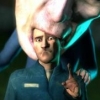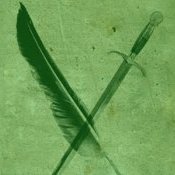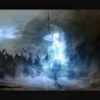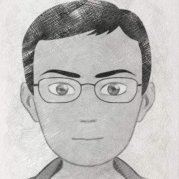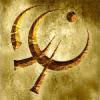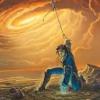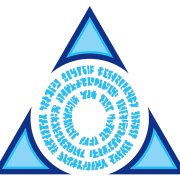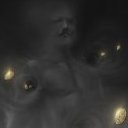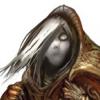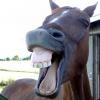Search the Community
Showing results for tags 'speculation'.
-
I didn't want to thread-jack, and although I'm sure there must be a good thread foe this somewhere, my forum-fu has failed me and I can't find one where this is the focus of the original discussion. So, how is it done? Does Odium wait until a Shard is already weak, before smashing himself against it (as per Vin taking down Ati, but more unbalanced)? I suspect if this was the method, he'd need a long time to recover as he'd inevitably be depleting his own essence by doing so. Others have speculated on the quote from Tanavast, that it may in some way come down to a fight between champions, some kind of Vassal chosen by the Shards. Still others have considered the idea that it in some way involves the larger population of a world, and that Alethkar and the Thrill may be a clue towards this. For myself, I don't know, but it's fun to speculate. As a final point, here's a quote from Elantris, the last line of chapter 6: A simple observation, or the legacy of Odium's visit to Sel? You decide!
- 28 replies
-
2
-
- splintering
- sel
-
(and 5 more)
Tagged with:
-
Okay, this isn't going to be a real theory, but I wanted to throw an idea out to be discussed, and its partly predicated on the material from the sample chapters, so I needed a thread in the BoM spoiler section. According to the Ars Arcanum, Hemalurgy is "dangerous to the Cosmere". You know what else is dangerous to the Cosmere? Odium. And I think it may be for the same reason. Odium is trapped on Braize (somehow) and the only way he seems to be able to have a direct influence on things outside of Braize is through the Voidspren. But if they can only bond with the Parshendi, that is, on a Cosmere-scale, fairly limited. Hemalurgic Spikes allow Ruin to influence and directly control pretty much anyone and anything, so far as we know, and Paalm had a Spike which somehow seemed to let another Shard (or entity; I haven't given up on you, Rust!) gain the same influence over her. What if the person influencing Paalm is Odium? We know that there was a Kandra worldhopper, and there's speculation that it could have been Paalm. What if she went to Roshar and got herself spiked by one of His voidbringers (if the Parshendi are the voidbringers)? Because of their so-called fluid bindpoints, I would think that Kandra would be one of the easiest creatures in the Cosmere to spike correctly without Ruin's intrinsic knowledge of Hemalurgy. So Paalm comes back to Scadrial with some new spikes and a new voice in her head. Somehow, maybe through experimentation, she figures out how to charge and bind a Spike such that it can grant her Allomantic and Feruchemical abilities. Then she dies and the other Kandra end up with her spikes to study. What if a somewhat amoral and ambitious Kandra (looking at you VenDell) decides that the best way to study the spikes would be to try them out? Now Odium has a new servant who he can continue to study Hemalurgy through, as well as spike at least one other Kandra (assuming that the Kandra who calls herself MeLaan is in on the plan). If Odium can develop an advanced enough understanding of Hemalurgy to successfully spike humans, or create hemalurgic constructs, he could begin to spread his influence across the Cosmere, which would be very dangerous indeed. WOW, that got real tinfoil, real fast. I still think the possibility should be considered, though.
-
40th Stanza of the Listener Song of Secrets Emphasis mine This could be interpreted as vague wording, but why does it say before us? Is there someone who knew the spren dearer than the listeners before both the listeners and the humans? Who?
- 4 replies
-
1
-
- confusing
- speculation
-
(and 2 more)
Tagged with:
-
We know very little about how kandra work. Even if they do clearly appear as kandra, instead of being fully in hiding mode, when they are not viewpoint characters, as MeLaan was not in SoS, we cannot truly take anything they say or do at face value. Though of course that was a different era, before Harmony, we should always remember that for a thousand years their very existence was the extreme long-con, them being the ultimate spies not against other people, but Ruin himself. Depending on your personal level of paranoia, MeLaan's comment that she is just showing everyone what they need to see to keep them on mission is either a bit of light-hearted fun, or extremely creepy. Therefore, let me start by saying that is this is all guesswork based on what makes sense and feels right to me. I mostly only have questions, and what few theories I do have lack any kind of proof, but hopefully you will find what I have to say interesting and worth reading. I am only mildly Cosmere aware - I lurk these forums a fair amount, and have read most major theories; however I do not on my own automatically think in Cosmere terms. Furthermore, I intend to find an interpretation that is character driven, not system driven. I certainly appreciate the very consistent and rule based nature of Mr. Sanderson's magic systems, however I consider characters more interesting as people first (e.g. certain behaviour may be a documented result of Cosmere stuff, but if I can find a personal reason for it, I will always prefer that). I believe my interpretation is based on text - albeit by arguably over-analysing things - without adding any speculation that is explicitly external to the books, but it is an interpretation, an alternative reading, and as such has little direct evidence to support it. With this disclaimer out of the way, I will now present everything as obvious facts for the sake of clarity, but do keep these first paragraphs in mind. 1. Background To understand Lessie-kandra, I first need to establish how her mind works. To do that, I will have to go back to TenSoon. This is especially helpful, because Lessie-kandra is compared to him quite heavily - I could of course question that information, but I do not have any reason to, and I think that that bit of insight is key. A very simplistic way to summarise what happened in the first trilogy would be that Vin's friendship allowed TenSoon's personality to manifest. Two things to note about this: a) his personality was there before, he was not actually completely empty - that was what drove him to take all the contracts, resent humans, etc. - it was merely not dominant and on the surface; Vin's actions provoked him to let his personality through, and develop, but it was not like flipping a switch - now you are a blank slate, now you are the real TenSoon. A good comparison - though I do not believe the two are exactly the same - would be to children. A teen has the core of their personality ready, but needs the experience and confidence to fully grow into it. I think I can be very brief here, by simply saying "coming of age". A kandra that chooses TenSoon's path - like Lessie-kandra did, for example - would be like a child, not having the room to become who they are, because their self is being suppressed by the personalities they keep taking on. Kandra, especially the old ones, are very dedicated to their roles. I think that Wayne's viewpoint chapters in both AoL and SoS give a good approximation of this, where he starts thinking like his disguise, to get into the role. Kandra must surely do something similar. Now, I want to point out that even in the case of kandra, I do not mean to go over the top with this, and suggest that they somehow lose their identities, or are truly blank slates; simply that their personal growth is delayed and very slow, spread over a long time - in some cases many centuries. One last thing to note: this is all about their personality, and what can best be described as their own awareness of it, and confidence in it. It is independent of their factual knowledge, or practical abilities. 2. Relationship with Wax I do not believe Lessie-kandra was in love with Wax. That is to say, I do not believe it was as simple as that. While it may not have been Harmony's - or Lessie-kandra's - intentional plan, I think it was logical for the Lessie-persona to fall in love with Wax, and vice versa. This approach is not very romantic, but it makes sense in the story; it is also something that happens in real life as well. Love can be mysterious and special, and all the rest, but also sometimes there are people that make a good couple, and it is easy to see why and how they would fall in love. The complications begin when we realise that Lessie-kandra's actual personality, her core, was also such that this relationship appealed to her. In the prologue, there are two interesting bits of dialogue with Lessie-kandra, that are very telling. First, she says that killing Wax would have been like killing what he stood for. This proves that she knew about him - in reality, very likely knew more about him than just his Roughs reputation; Harmony sent her to be his bodyguard, he must have told her at least something of why Wax was important - and it is a very profound statement. It also reveals an appreciation of Wax, his goals, and his morals. Second, she talks about how she did some things for Granite Joe she is not very proud of. I do not think this foreshadows her turning against Harmony, however I do think she was talking about more than just her cover. We know that she was always somewhat unconventional, and did things most kandra find distasteful. We also know that Harmony made use of this - indeed, this was why she became Wax's bodyguard. Knowing about Wax, and how important he is, she felt she was doing something important and worthwhile in this job, something she could fully get behind. Just for the record, I do not think there is anything inherently unlikely about a kandra falling in love with a human - I only question it in this specific case. In summary, the high regard she held Wax in was genuine, and part of her "normal" personality, however it, and their being in love, was also tied to, and very probably started by, the Lessie-persona. 3. Chain of events - going rogue Here is where things get really confusing. At first glance - and first reading of SoS - the events seem to be: I. Harmony wants Wax to return to the city. II. Lessie-kandra does not approve, believes Wax would be happier staying where he is. III. Harmony pushes Lessie-kandra hard, but without taking control of her. IV. Harmony arranges the Lessie-persona's death. V. Lessie-kandra snaps and goes crazy [more on this in the last part]. VI. Lessie-kandra begins to plan and execute the downfall of Harmony, to free everyone from him. VII. Lessie-kandra gets and uses one or more trellium spikes. VIII. Lessie-kandra removes one or more of her spikes. The order of these events is implied, however not confirmed. In fact, the events themselves are uncertain; IV. especially is questionable. I. and II. are pretty much undisputable and I have nothing to add. III. We do not know what Harmony pushed Lessie-kandra to do. It could be that he wanted her to encourage Wax to return to the city, maybe even return with him. There is some evidence for this, and it is the most benevolent reading. It is also the only scenario which could lead to Lessie-kandra arranging the Lessie-persona's death herself. On the other hand, it could also be that the thing Harmony pushed Lessie-kandra into was IV. More, a possible extension of this would be that Harmony was also the one who prevented Lessie-kandra from coming out to Wax initially. While by the end of SoS, after she becomes unstable and a year passes, I can grudgingly accept that she just wanted to spare Wax because she knew that the truth would hurt him, this does not work at the start. It is very difficult to imagine that Wax would be overly upset if "Lessie" just got up after he shot her and explained things right then and there (or within a few days). IV. This is the biggest issue. Who arranged it? Harmony or Lessie-kandra? I am not going to go into the latter too much, because to me it makes no sense. The Lessie-persona's death was what made Wax return to the city, which is precisely what Lessie-kandra did not want to happen - if she arranged her death, she miscalculated very badly, and that does not seem to fit with her brilliant, extremely methodical nature. Even if Harmony arranged it, though, there are problems. The way Bloody Tan talks seems very in line with what Lessie-kandra thinks. Why would this be the case? If he is just a random criminal who happened to be one they were chasing when the Lessie-persona needed to die - honestly though, how many people on this forum are willing to believe that? - he should not be saying anything relevant at all. But if he is not a random criminal - who is he? His dialogue seems to be counter to Harmony's goals, which makes me believe that even though Harmony arranged to use him, he is not somebody Harmony is directly controlling - either via his godly powers, or just by talking to them and asking them to help, as he sort of does with Wax. However, since this the point where Lessie-kandra is being the most heavily influenced, and her death is not something she wants, I find it unlikely that she would cooperate with Bloody Tam. It is worth consideration, however, that maybe since Harmony was not completely controlling her, once she realised what was going to happen, she gave Tam information, so that it would get back to Wax and be a clue to him. V. to VIII. These are things we know happened, but the order is not determined at all - both just among these four, and their location on the list. It seems likely that Harmony's heavy handed influence was what made Lessie-kandra go crazy and turn on him, but not certain. It could be argued that by refusing to go along with his plans in the first place, warranting such heavy intervention, she was already rogue. Did she go crazy and remove her spike(s) out of madness, or did she go mad because of a lack of spikes? Did she remove her spike(s) and look for alternatives then, finding trellium, or was gaining access to trellium what triggered her to removes her spike(s)? If having trellium made her confident enough to remove her own spike(s), and removing her spike(s) is what made her insane, does that mean the she had access to trellium before she snapped? It has been noted that Harmony seems very troubled by her ability to hide, yet does not directly tie this ability to her lack of spike(s). Further, Harmony implies that the madness is a result of spikelessness, yet I do not think he ever comes out and explicitly states that Lessie-kandra only went insane because some of her spikes were removed. All of this could be made more crazy, if we assumed that she got a trellium spike in her during her time running around in the Lessie-persona. Maybe that spike influenced her, or opened her to influence. Maybe that is why she started opposing Harmony's wishes in the first place, requiring him to step in. This is probably more of a stretch, but we know for certain nothing that would prevent this. Primarily the point I am trying to make is simply that despite SoS seeming like it reveals many things and appearing shocking, we actually know very little of what exactly happened for sure. Any of these variations could be true, or any other combination of these events could have happened, and it would still fit with the tiny amount we can be certain of. Also, it is important to note that Harmony likes to interfere as little as possible, wants to ensure people have independence from him and free will as much as possible, and the idea of personally taking care of things is distinctly unpleasant to him. By SoS, after Lessie-kandra has destroyed a dam, causing who knows how much damage, and murdered a lot of people, he is ready to handle her, but the question is, was he always? I find it entirely possible that Lessie-kandra exploited Harmony's principles. She can very easily be opposed to him, and work against him, and as long as she keeps her actions below a certain level of visibility and wrongness, Harmony would not directly involve himself. For example, could she break into an empty house and steal some jewellery or would that be something that Harmony find offensive enough to prevent himself? Could she rob a bank, if she only used a fake gun and made sure not to hurt anyone, only scare them? Could she murder one person? Two? At what point exactly would Harmony decided to go Old Testament on her? I think murder is a pretty good threshold, but we cannot know for sure, and in all honesty, it does not really matter. The only important thing is: could she start working on her evil plan and by not doing any technically wrong for a while, avoid Harmony's ire? One last thing to note in this area: Harmony is not omniscient. Under normal circumstances he can probably find most people and information that he wants, but he has to work at it. This is my lack of Cosmere knowledge showing, so please do correct me on this point, but I actually think he cannot directly read the minds of non-spiked people - I recall that this is mentioned in SoS at one point and it was a main plot point in the first Mistborn trilogy, though that was only Ruin. The numbering above is what I prefer. I. to III. seem fairly certain, and I think arranging the Lessie-persona's death makes more sense for Harmony than Lessie-kandra. I also think that tying back to 1. and 2. the Lessie-persona's death was what made Lessie-kandra go crazy. The reason she did not go to Wax and reveal the truth initially was that she could not do it. Their relationship was tied very strongly not just for Wax, but for her as well, to the Lessie-persona. On top of that, acting as her true self was not something she was overly used to or comfortable with. When she lost the Lessie-persona, which she grew fond of - she even says at the end she wanted to become her - and which was the core of her connection to Wax, she simply could not take it. I also think that as I mentioned, she did not immediately remove her spike(s). She is ancient and extremely crafty. She fully exploited Harmony's principle's against him. She started planning, and somehow, somewhere along the way, she was given trellium. Armed with that, she only removed her spike(s) once her plan reached the point where Harmony would have stepped in, and after she was certain it would work out for her, thanks to trellium. The only thing I am baffled by is Bloody Tam. I cannot for the life of me figure out a scenario that makes sense. In a way, this makes everything I said so far look weak, because I cannot work everything in - I admit, this does bother me, however I have no choice but to accept it, because no alternatives I could think of, or read on these forums, properly account for his oddity in a way that is fits and works with everything else. Mr. Sanderson's consistency is beyond question, so I am sure there is a logical explanation, but it has not been found yet; or at least it has not yet been presented in a way that I find convincing and acceptable. 4. Insanity Much has been said about Lessie-kandra's supposed insanity. Serious mental health issues aside, I think there are four primary ways in which one can be insane. First, the worst case, is a loss of the ability to think normally. People in this category are no longer capable of making the same logical connections a healthy person does. This prevents them from functioning in many situations, causes their behaviour to be off, and their plans, if they can make them at all, are not workable because the steps do not properly follow each other. Lessie-kandra's pragmatic cognitive abilities have not decayed. Her planning, attention to detail, and execution of said plan prove this. Second, when people lose grip on part of reality. It can be summed up in one word as delusion. This and the first one can occur at the same time, but they are separate things. The first one is about how you connect two points, and this is about what those two points are, to put it simply. In this case, the affected person may make plans that are well structured, logical, may make arguments that are convincing; however the key issue is that one or more part of their reality is wrong. To give a blatant and silly example, if a very charismatic and talented politician suddenly became convinced that aliens [in the sci-fi sense, not immigration] run the government and started rallying people against them, he could have some success, by virtue of his talents - he would still know how to work a crowd, for instance. Lessie-kandra could be considered in this group depending on what you think about her plan against Harmony. I do not think that is the case, however. Needless to say I do not approve of mass murder, but I do not think her conclusions and goals are inherently incorrect. Third, we will often call someone crazy for doing something too far from normal. Serial killers are often in this category - though they can suffer from the first and second version too. A serial killer that kills their victims in a sadistic way for no overall purpose other than the fact that he enjoys it can very easily be seen as crazy, even if the previous two do not apply. This definitely does not apply to Lessie-kandra. At first glance her murders, some of which are quite gruesome might seem to qualify, however there was always a point to them. To repeat, this is not about whether I approve or not, of course, but there is a difference between a killing that serves a rational purpose, and one that is done just for the sake of it. Fourth, which I can best describe as "unreasonable focus". This is not a very good description, to be honest, but I cannot think of a better one. The best way to explain, I think, is via example. A common trope is that close to the final battle, the hero has to do something very difficult. "I will defeat the evil overlord by walking through his maze of doom." "But Bob, that's crazy!" Other variations include the heroic last stand or suicide mission. Many different motivations and circumstances can be the cause of this, but I would argue that very often the underlying mentality is one of "it does not matter how hard this is, if I fail everything is lost, I have to commit myself to this task fully and without any reservation or consideration and concern for any other priorities". Despite the examples, this is of course not a necessarily good thing. Such release of discipline and control can indeed be crazy - and very dangerous, in more ways than one. This is the version that best describes Lessie-kandra. The reason she can be fairly described as insane in SoS is because she has decided on a goal, and has set her mind on achieving it to a truly radical extent.
-
Note: I haven't read White Sand. If someone who's read it considers it plausible / impossible, please mention it below. Spoilers: Part for length, and part for SoS major spoilers (even though I don't have to).
- 11 replies
-
2
-
I thought I'd better post some Mistborn theories before Shadows of Self/ Bands of Mourning came out, in case they were confirmed or debunked. The first of these: MECHANICAL HEMALURGY. These are some separate facts in my head which caused me to believe that Hemalurgy can somehow be transferred to machines. While I haven't exactly worked out how, I am fairly confident it can be done. Here are some of the things that caused me to start thinking about this. Exhibit A: The machine built by the Ones Above in Sixth of the Dusk. Sharders seem increasingly certain that the Ones Above in Sixth of the Dusk are the Scadrians, who have gained access to space travel. We do know that it is set shortly prior to the sci-fi Mistborn Trilogy. One of the only things we know about them is that they built a machine that detects Avian (or the Investiture inside the Avian). This sounds almost like the capabilities of bronze, being able to detect the metals inside someones bodies. We have WoB that bronze can detect non-Scadrian magic in it's radar as well. So, I believe that this is one such machine that can convert Hemalurgy from a human into a mechanical operation. Exhibit B: The Southern Continent of Scadrial. We have WoB that they have magic there, but he has said it is used 'quite differently'. I believe that this is due to the presence of mechanical objects. They would have discovered it long before the northern continent, because they didn't have a stagnant 1000 years when the Lord Ruler took over. This means they would have had 1000 extra years to tinker around with this, and see how it works, as I believe they have done. Why Hemalurgy? Well, we know that inanimate objects don't have Investiture by natural means (Brandon has stressed quite strongly that metals don't contain Investiture, they merely 'unlock' the ability to access the Investiture inside yourself). Therefore, it must be 'given' to the machine somehow. So... Hemalurgy. What do you guys (and girls) think? Have I finally gone stark-raving mad? Or is there something salvageable to this theory? I'll get sources for the WoB's mentioned as soon as I can be bothered.
- 29 replies
-
2
-
- investiture
- theory
-
(and 3 more)
Tagged with:
-
This isn't a theory. This is just an idea I came up with recently that I thought I'd though to the real theorists here. Also, this might go better in the Mistborn section, but since this had Cosmere level applications, I decided to put it here. With that out of the way, if someone had a sample of a foreign form of investiture, then, through a combination of storing/tapping investiture and identity, would someone be able to modify their spirit web to allow access to said form of investiture?
-
So I was reading The Way of Kings for the 7th or 8th time, and in the prologue, Kalak doesn't want to go back because he will end up "Back to that place he dreaded. Back to that place of pain and fire." In the devotaries, they say the men who are the best at their Calling will help the Heralds take back the Tranquiline Halls in the afterlife. If the heralds are sent to a place like Hell in between Desolations, they would not be able to fight to take the Tranquiline Halls. Any thoughts?
-

theory Cohesion and Tension (and Division) Part 2
ostrichofevil posted a topic in Stormlight Archive
Several months ago I posted a theory on what the surges of Cohesion and Tension do. Here is a link to that post, but I'll sum it up below: Cohesion: Weaken, or even dissolve the intermolecular bonds within a substance. Tension: Strengthen the bonds within a substance However, this theory has a major problem: the actual force of cohesion (wikipedia page) holds substances together, while in my theory Cohesion breaks them apart. Also, my idea for the Surge of Tension doesn't have much to do with what Tension actually is. (and the Coppermind page says that it alters the stiffness of an object.) So, here is my new theory for what the Surges of Cohesion, Division, and Tension do: Cohesion: Strengthen the intermolecular/atomic bonds within a substance or object. Example uses: - Create a wall of solid air by strengthening the bonds between the air molecules. - Make your armor virtually impregnable by strengthening the metallic bonding. Tension: Make a substance stiffer--increase its tension Example uses: - Stiffen a carpet, allowing people to walk on it--and then when they've fallen for your trap, release it, and watch them fall into your strategically located pit. - Walk on water by increasing its surface tension Division: Weaken, or even dissolve the bonds that hold an object together. The opposite of Cohesion. Example uses: - Weaken the intermolecular bonds that hold your enemies together, and watch them dissolve into piles of sludge. - Destroy the bonds that hold a wall together, allowing you to walk right through. That's my new theory. Please reply with feedback, speculation, and/or possible uses for these powers.- 20 replies
-
2
-
- stormlight archive
- cohesion
- (and 8 more)
-
Possible spoilers for WoR below. Why are the Heralds present during Gavilars assassination? The Heralds I noticed are 1. Nalan the Azish man with the white birthmark on his cheek. Or was it a scar? 2. Another Herald (Kalak/Ishar) talking to Nalan. “I’m worried about Ash.” “You’re worried about everything.” Jasnah hesitated in the hallway. “She’s getting worse,” the voice continued. “We weren’t supposed to get worse. Am I getting worse? I think I feel worse.” “Shut up.” “I don’t like this. What we’ve done was wrong. That creature carries my lord’s own Blade. We shouldn’t have let him keep it. He—” Here I think "Ash" = Shalash, "That creature" = Szeth, "my Lord" = Jezrien, "Blade" = Honor Blade 3. Shalash is/had been present there. She is confirmed to be Baxil's mistress. Szeth notices that Shalash's statue in the palace was conspicuously missing while the other nine heralds were represented. It had been destroyed by her. Szeth brushed by, continuing past a line of statues depicting the Ten Heralds from ancient Vorin theology. Jezerezeh, Ishi, Kelek, Talenelat. He counted off each one, and realized there were only nine here. One was conspicuously missing. Why had Shalash’s statue been removed? What is so interesting in a treaty between Alethi and Parshendi that warrants the attendance of 3 (atleast) Heralds? It seems too much of a coincidence whatever be the significance of the event. Did they attend knowing that the Parshendi were voidbringers and that this event will have some crucial part to play in the Desolation to come?
- 27 replies
-
6
-
- stormlight archive
- speculation
-
(and 4 more)
Tagged with:
-
This is my speculation about the nature of the Truthwatcher Immortal Words, and most below is a direct trascription of my post in the "Anything you felt should have been done differently in The Stormlight Archive?" topic: First, I believe the Lightweavers are not the only order with only one oath. I believe all orders that don't operate with a strict hierarchy and are unlikely to be part of "field action" don't need rigid guidelines and can act under a more subjetive and nuanced morality. Or, if the spren is not picky, just follow the first oath and be done with it. Now, lets look at some what we know of truthwatchers: 1.They were secretive. 2.They were esoteric. 3.They were tactful and careful. 4.They see the future. Now, lets look at what we know about another form of future sight: From the reddit AMA.I have theorized that this is how all future sight in the cosmere works: you plug your subcounciouss mind directly into all nearby cognitive aspects and their perceptions and calculate what will happen if no new element enters the system. What does this have to do with the Words? Well, look at what I posted in the other thread: The truthwatchers are said to be one of the most secretive orders. I believe there is a pragmatic aspect to it. If we consider true the theory that all "future sight" in the cosmere is actualy mathematical predictions done with temporary nigh onmiscience, like a powered up diagram, then it makes sense to withold information until it is most useful, since any new element added to the system makes predictions made before it was know more likely to fall apart. However, if the only people with the knowledge have a strong natural predisposition to keep it to themselves, then they risk being uselessly fatalistic, since their prophecies always come true because they decided it was better to endure them than risking change. This way, the progression of the order would relate to keeping this balance: holding on to secrets and staying in the shadows, but revealing the truth and stepping into the spotlight when it is needed. This means their progression depends on first keeping something hidden and holding on to it long enough before revealing it, much like the lies lightweavers must tell themselves in order to later destroy them, except in relation to other people. This also applies in a more personal scale, with stepping into the light or staying in the shadows. I believe it will be an as important part of Renarin's journey to stop risking himself uselessly for his family as it will be to learn to be more open about his actions. The interplay of light and shadows, revelation and occultation, also enhaces the esoteric air of the order and works as a powerful imagery, but on the same hand enforces the isolation of the truthwatchers, because their preference for watching over acting, their extreme discretion and their openly mysterious attitude make them seem suspicious, and when they come forward with information that changes everything without saying why they witheld it for so long, it comes as if they were manipulating everything like shadowy puppetmasters, when those who are more likely to be the ones manipulating people do so under a mask of normalcy.
- 1 reply
-
7
-
- speculation
- theory
-
(and 4 more)
Tagged with:
-
I was re-reading both WoK and WoR and started to wonder about Sigzil. We know that Sigzil is definitely native to Roshar and that he is a trained Worldsinger. This is interesting in itself, but we have to remember that he was trained by Hoid/Wit. Given that, exactly how much does Sigzil know about what is going on in the Cosmere? Does he know about Odium, about Hoid's plan and the other worlds? About what is going on with Kaladin? There are places in WoK (I can't recall exactly where at the moment) where Sigzil looks at Kaladin or says something to him and seems to know A LOT more than he is letting on. Hoid is a very enigmatic character that is hard to get to know, and I think that Sanderson might be setting Sigzil up as our means of getting to know him--and his motives--better. What do you all think?
- 14 replies
-
2
-
- stormlight archive
- characters
-
(and 4 more)
Tagged with:
-
I don't know about any of you guys, but I always thought that the fact that so little has been said about the effects feruchemical powers of nicrosil was intriguing, combined with the fact that it mentions the word "investiture", which I saw as a goldmine of hidden fun. So I was reading through the rulebook for the Mistborn Adventure Game, and I came to the section where it talks about nicrosil, and to my surprise, it had a whole bunch of information on it, that you can't find anywhere else. Presumably to make it usable in-game, so I suddenly had a brainwave and wrote a crap-ton about the potential powers of feruchemical nicrosil on the actual wiki page, but most of it is speculation, so in case of its potential erase, here is what I wrote: Although the feruchemical uses and effects of nicrosil have not been canonically explained outside of the appendices in the books, the rulebook for the mistborn adventure game states that nicrosil can be used to convert stored feruchemical attributes into a generic form of investiture that can then be drawn upon to augment any feruchemical attribute. For example, if a feruchemist has stored up a lot of warmth but suddenly finds himself in need of some extra health, he can convert some of his excess warmth into generic investiture (which is shifted into his nicrosilmind), and can then draw upon the investiture as if it were health stored in a goldmind. The limitation being that he needs to have access to all three feruchemical abilities and their respective metals, this means that a simple nicrosil ferring is incapable of performing such a feat. However, the rulebook also states that any power gained from an external source, such as an allomantic duralumin or nicrosil boost, or even power gained from the well of ascension or the mists could be stored in a nicrosilmind for later use. This means that a feruchemists who travelled to other worlds could gain access to extra investiture. For example, feruchemist on Roshar could potentially store the investiture provided by highstorms in the same way that Returned can consume it in lieu of breath. Despite what can be inferred due to previously established rules on investiture, (such as all investiture being considered fundamentally identical) due to a lack of evidence, it can only be speculated that investiture stored in a nicrosilmind could be used to fuel other magic systems. For example, a twinborn using his feruchemically-stored investiture to power his allomantic ability, instead of having to burn a metal. Or even the reverse: a twinborn burning his metal, but storing the power in his nicrosilmind for later use, instead of gaining the immediate effect. --- Now I know it is a lot to guess at, and we dont know how much we can trust what the tabletop game has to say about nicrosil, but I honestly think that this really fits with what we know about investiture throughout the cosmere. Anyway, if you guys have anything to add, or discuss, I'd love to hear it!
- 4 replies
-
11
-
- nicrosil
- investiture
-
(and 5 more)
Tagged with:
-
Okay, final numbers are in. Sorry for the confusion(s)... Originally I was going to post this as a reply to Joe ST's comment in the Brandon Sanderson AMA thread, but my reply started getting just a bit long and technical, so I figured I'd post it separately. Not necessarily because it merits discussion (though it might merit a reaction), but because I wanted to keep it independent of the AMA. So. Turns out, as far as our viewpoint characters know, the population of the Final Empire was about 100 million people before the events at the end of The Hero of Ages, so we are talking Era 1. By the time The Alloy of Law rolls in, Era 2, we are down to about 15 million (again, as far as our protagonists know). This is enough information for us to make some educated guesses about how impactful Ruin's release, as well as Vin's and Harmony's tinkering with the planet was. Let's look at our Earth as a baseline. According to World of Meters' page on World Population, we entered the Industrial Age with about 770 million people (a number we don't actually care about here) and exhibited a population growth rate of about 1% (1.0059% for the period between 1760 and 1804). The Final Empire takes place during a kind of pre-Industrial era, skaa were created (or modified) to be more fertile, but I find it likely that more of them were dying when compared to our history, so I think establishing a 1% population growth rate for the Final Empire is, if not accurate, then at least a good starting point. Given that about 300 years have passed between The Hero of Ages and The Alloy of Law, knowing that we reach about 15 million people, and assuming the 1% (1.00596%, actually) population growth, we can calculate that all of (known) Scadrial had about 750 thousand people when it began repopulating. From 100,000,000 to 750,000. That's 99.25% of the population gone. Over. Ninety. Nine. Percent. And you know what the worst part is? I don't know if 1% is not too low. People tend to, um... get active after surviving disasters, something about the human spirit likes to celebrate the death of others and its own survival with procreation. Harmony had just remade the entire world, I would be surprised if he didn't try to make things just a little better for his people. You know, kill and infectious disease here and there, boost people's immune systems, maybe even tinker with the fertility rates so that people have an easier time repopulating the planet. If we raise that 1% to 1.20% we end up with 420,000 people surviving the apocalypse (99.6% extinction)! You know what the population growth rate was in 1965? 2.19%. If Scadrial had the same annual growth rate during the 300 years between Era 1 and Era 2, Harmony would've had only 22,500 people to work with! Twenty-two-fraking-thousand! Want this as a percentage of the Final Empire's population before that? 99.98. How crazy is that?! So, two edits later, we are back where we started - if my estimates are anywhere near correct, we are talking about 99% extinction rate. You know, no big deal. For comparison, the Permian-Triassic extinction, Earth's worst extinction, wiped out only 95% of all land-based animal life on the planet.
- 35 replies
-
17
-
Brandon recently released a statement about what he's doing this year, and in it, he mentioned that when he finished the Stormlight archive, he would write what he dubbed the 'big' Mistborn trilogy, a sci-fi one. That got me thinking, what would happen if allomancers visited other planets in the Cosmere? I imagine there would be battles, perhapse some revelations about Investiture. What does everyone else think?
- 56 replies
-
3
-
This is pretty simple, but if you could think of another Feruchemical power, what would it be? Bonus upvotes in fifteen years if you call one that we discover in the third Mistborn trilogy... For example: Storing Time. This would produce a Cadmium/Bendalloy effect, though only for the Ferring. Storing Experience: Somewhat similar to Copper, this would store practice and experience in a given field as opposed to general knowledge, i.e. a pianist would store his sheet music in a Coppermind and his piano skill in his Thoriummind (The God Metal of an as-of-yet unseen Shard on the Shardworld Valhalla). Speculate!
-
<SPOILERS FOR MISTBORN> I was reading the Way of Kings the other night. I couldn't sleep and it was pretty late at night so cut me some slack. I think it was Interludes 5 at around page 500. The Spreniolgist (spren studier) who was looking for intoxicationspren mentioned that he was a pretty rare thing. Aimans, I think is what they're called. They have the ability to change the color of their skin. This reminded me of the kandra from Mistborn. I have no idea how they are related, but the ability is pretty similar to the kandra's flesh manipulation. This is completely speculation. I have no evidence and I'm not sure about the how. But that's what you guys are for, right?
-
As the topic says, I've been pondering on this subject lately, especially considering that Peter may have hinted (keyword: may) that the Unmade are Voidbinders. But I'm getting ahead of myself, here. Let's start with what we do know about Voidbinding, from the Ars Arcanum, and then I'll bust out the random fancy: It's not much to go on, but my ruminations began with the bolded key phrases. Consider the following: Voidbinding is, by implication, esoteric. The definition of the word esoteric alone suggests that there's a very specific factor to allow for the usage of the power (and/or is exclusive to possibly the Unmade). There are multiple levels of Voidbinding. Speculation took me along the idea that each requires some state to be true in order to reach the next one. Sound familiar? I think of the Heightenings as sourced from Endowment's manifestation of Investiture, specifically that a certain number of Breaths are required to reach a certain level of Heightening. I think there's a similar component here, but the requirement for reaching the various levels of Voidbinding are different. Key in what we know about the Unmade, specifically the following from the Diagram: Let's assume for now that the Diagram is spot on with respect to the Unmade and how they're akin to spren. This would therefore imply that they lack a substantial Physical component to their being, that they are mostly Cognitive. If they really are Voidbinders, why would this be a common thread, unless Voidbinding requires a willing sacrifice of oneself in order for the Shard's power to take root? It's almost a corroborated idea, if Rlain's comments on the listener gods' (presumably the Unmade) are indeed factual, that those gods literally gave up aspects of themselves in order to become dangerous, powerful entities. They "unmade" themselves in exchange for Voidbinding powers. Thus, we have some mindless agents of destruction, because they largely gave up sentience in the (I assume) hope to destroy the opposition with the power gained in exchange for that loss of cognition. I then wondered the following: Suppose there are Unmade who simply are just 'mindless' forms of destruction. What if those, then, are therefore the most powerful, because they have "given of themselves to destroy" to such a higher extent, that they have virtually little substance to them, that they're almost literally are just forces of destruction? In other words, they sacrificed almost all of their Physical and/or Cognitive and/or Spiritual components in exchange for attaining higher levels of this power, which are also the most powerful and wide-reaching. Alternatively, it could simply be the case that by sacrificing a specific attribute in one's self (physical form, sentient thought, etc.) gains one access to a specific 'level' of Voidbinding. The chart for it resembling the Surgebinder chart is, however, troubling, and doesn't support the idea of a "prerequisite" system as with Heightenings. Requiring the sacrifice of a specific aspect -- dare I say, Essence? -- on the other hand... Thoughts?
- 7 replies
-
5
-
- stormlight
- voidbinding
-
(and 1 more)
Tagged with:
-
Simply put, a planet is in motion. Therefore a speed bubble has to be moving with the current (planitary) reference frame. Would the same apply for a spaceship? Cadmium bubbles would allow survival of space flights at non relativistic speeds but Bendalloy moving in a different reference frame would allow travel great distances apparently instantaneously.
- 8 replies
-
5
-
- mistborn
- alloy of law
-
(and 3 more)
Tagged with:
-
So as I'm looking at a quote from Brandon: Now, as we've understood it, this means that whatever power Allomancy taps into, Feruchemy can siphon it off. Taking it into a larger context however, you can realise that this means that an End-Neutral System can effectively be powered by a End-Positive System. Imagine a Feruchemist Worldhopping the Cosmere, only to return to Elantris after an exciting day - as they arrive, they activate the Aons they have inscribed on their MetalMinds, and instantly they are fully recharged. That's only where the possibilities begin! (I've just realised that using Stormlight to fuel Awakening is essentially Compounding - good on you, Vasher). Sorry if this has been realised before, but I just had my mind blown and needed an outlet. I've also very curious to see how this relates to End-Negative Systems, or even Reverse-Compounding (as I believe we have WoB that the Lord Ruler enhanced his Allomancy with Feruchemy). On another note, I'm going to begin compiling notes on how to make the most overpowered being in the Cosmere. Examples of this would be abusing this version of Feruchemical Compounding, an Awakened Mistcloak, Nahel Bond Spren, Awakened sword, Honourblade, etc,. I would be most delighted to see if anyone else can come up with some overpowered combinations.
- 8 replies
-
6
-
- theory
- speculation
-
(and 6 more)
Tagged with:
-
The Advent of Squires. My Theory is simple: squires gain their power through loyalty to and admiration of existing Knights Radiant, Thus acquiring a bond to the Knight, rather than to an actual spren. This ability is what separates the Nahel Bond, and Knights Radiant from Ancient Surgebinders. Rules: 1. it requires a Knight Radiant in full status (all three oaths) to attract Squires. This is why Squires only started appearing after Kaladin said his 3rd oath. 2. Squires have only one oath: the first oath, shared among all orders of Knights Radiant. 3. Squires are not bonded to a spren; they derive their ability to breath Stormlight from their bond to a Radiant. (Lopen would be bonded to Kaladin, etc) 4. Squires cannot utilize surges, but do gain enhanced healing, strength, etc. from holding stormlight. Anchiently, Squires likely used fabrials to mimic the surges they lacked. Consequences: 1. The number of people able to utilize Stormlight grows exponentially, rather than logarithmically. The number of people able to utilize stormlight increases drastically. 2. The existence of Squire allows an 'introductory phase' in which a person can get used to following the Radiant Oaths, or even transfer from one order to another, prior to any spren actually agreeing to bond them. This reduces the risk of a spren being killed by lack of faithfulness to oaths. 3. 'side effects' from the use of powerful Fabrials (such as soulcasters, and other fabrials which mimic the surges) are mitigated. {Note that soulcasters, over time, gain a very odd appearance, stone-like flesh, etc. one who could breath stormlight would have these effects healed long before they manifested fully.} 4. The 17th shard may make use of Squires, allowing their world-hoppers to power their off-world abilities with stormlight. (a separate theory in its own right, but worthy of consideration) EDITED: to correct and clarify
- 16 replies
-
2
-
So lately I’ve been fascinated with Realmatic Theory, and here are a few observations and speculations I’ve made. So far, canon Realmatic Theory tells us that the Cosmere is made up of three Realms: Physical, Spiritual, and Cognitive. All entities exist in the three Realms, but are manifest more strongly in one and are shadowed in the others. However, Brandon has noted that Sazed has not yet touched Heaven or Hell nor does he know what the final beyond contains. He has, however, made contact with some people who have been sticking around in something of a middle place. This very strongly implies that there are three realms; and I do not mean the Physical, Cognitive, and Spiritual Realms. Here is how I think of the three greater realms. Brandon’s nomenclature, which is almost certainly not canon, is in parenthesis.The Mortal Realm (Cosmere): This is the Realm we’re most familiar with. It is governed by Canon Realmatic Theory; namely, the Physical, Spiritual, and Cognitive Realm. This is the most relevant Realm as the vast majority of Cosmere stories take place almost exclusively here. Speculations: The interactions between the three Realms has been difficult to explain due to a lack of concrete, canon information. Even some of the canon information is suspect as it is the observations of in-world characters who are capable of being mistaken. So, without any supporting evidence, here are a few of my hypotheses. The Mortal Spiritual Realm allows for Investiture, which transcends the three Mortal Realms, to flow between the Divine Realm and the Mortal Realms. Adonalsium is described as being the, "Power of Creation," but isn't, to my knowledge, referred to as God. This is especially intriguing when you consider that the Cosmere takes place in a dwarf galaxy in a larger Universe. If Adonalsium was God, why would it choose to only be involved in a dwarf galaxy rather then being equally present throughout all of Creation? If Adonalsium is merely a tool of the Divine, then its exclusion from the rest of Creation isn't quite so unusual. Not to mention that the idea of humans literally destroying a God is absurd, even in the fantasy genre; misusing and breaking a portion of God's power, however, is plausible and makes for an interesting and compelling story. Brandon mentions both Heaven and Hell in the above quote. He has noted elsewhere that there was a Cosmic Force that opposed Adonalsium. If Adonalsium is a tool of Heaven, then it stands to reason that Adonalsium's opposite is the tool of Hell. Several real world religions explore the concept of Holy and Evil deities competing with each other via their mortal servants and followers. On Roshar, Tanavast suggests to Dalinar that he should attempt to force Odium into using a champion. Even in the Cosmere there is precedent for deific entities using mortals to settle disputes. This supports my hypotheis that the entities of the Divine Realm use the Mortal Realm, using the Mortal Spiritual Realm as a medium, as a battleground for their disputes. Perhaps the force that opposed Adonalsium influenced humanity enough to have them Shatter Adonalsium. The Divine Realm (Final Beyond): We have next to no exposure to this Realm. Brandon specifically mentions Heaven and Hell and refers to both together, in my interpretation of his quote, as the final beyond. This is the location of the afterlife. Speculations: This is likely where the truly significant, yet behind the scenes, conflicts are taking place. There is a Heaven and a Hell and there isn't a myth, legend, or religion in yhe real world that has a Heaven and Hell that are not in conflict with one another. It is also unusual for Holy and Evil to directly war with each other; they prefer to use mortals like a divine game of chess. Investiture transcends the Mortal Realms. Shards of Adonalsium are large, sentient pieces of Investiture. Shardic actions are determined by Intent. I've already proposed that the Mortal Spiritual Realm is the medium through which Investiture from the Divine Realm manifests. My hypothesis is that Investiture is a spectrum, much like the frequency of sound waves, and that different Intents fall on that spectrum. If you pluck a single string on a guitar and the string adjacent to it is tuned to the same note, the second string will vibrate from the soundwaves of the first while the other strings are unaffected. In this case, one string is in the Mortal Spiritual Realm and the other is in the Divine Realm. When Shards use Investiture in the Mortal Realm according to their Intent their Mortal Spiritual Intent reverberates in sync with Divine Investiture and energy can then flow from the Divine Realm to the Mortal Realm. Note to Self: come back and explain that better. Purgatory (Middle Place): Again, we have nearly no exposure to this Realm. This is where Kelsier waited to take up Preservations power. We know that you need strong ties to the Physical Realm in order to linger here. Speculations: This actually just plain baffles me. -------EDITS-------- Edit One: Improved formatting. Removed speculations from the end of the post. Edit Two: Added Speculations under the Mortal Realm, Divine Realm, and Purgatory.
-
I believe Brandon has said that their will be a flashback from each order of nights radiant so from this we can extrapolate. 1st set Kaladin - Windrunner 1 Shalan - Lightweaber 2 Szeth - Skybreaker 3 Eshoni - Willshapers 4 (unconfirmed but speculated willshaper) Dalanar - Bondsmith 5 2nd set (not in this order) Taln - Stonewards 6 Lift - Edgedancers 7 Jasnah - Elsecallers 8 Renarin - Truthwatchers 9 Chanarach - Dustbringers 10 (unconfirmed but known to be a 2nd herald) Although it is unconfirmed it has been speculated and i agree that Eshoni will be a willshaper leaving only the order of Dustbringers left for the 2nd herald making her Chanarach.This seems even more likely when you consider that we now have 5 male characters and 5 female characters just like the original heralds and how well Willshaper fits Eshoni who was called the Explorer on the back of the book. Could someone link me to the quote where Brandon said there would be a book for each order I couldn't find it.
- 25 replies
-
- speculation
- heralds
-
(and 2 more)
Tagged with:
-
I don't know if any of this has been posited yet, but this idea fascinated me. I got really excited about the Stormfather in WoR. So here's my theory/speculation about him/it. He refers to himself as a sliver of Honor (well, of the Almighty, but same thing) multiple times: He also says: Now, we understand that a sliver is an entity that has held most of the power of a shard for a time then released it, examples being (spoilers for Mistborn) If the Stormfather is a sliver, then when did he hold the power of Honor? I believe that it was when Odium killed him. When Odium killed Honor, by which we really mean he killed Tanavast, the Stormfather, who was present somehow, took up the power, did something with it, then released it. I assume that Odium did something more than just kill Tanavast; it would be lazy to just let the power sit there. So maybe he and the Stormfather clashed or something, and that is when the Stormfather fled, as he said. Now, based on his name, the obvious relation between him and the storms, and what he says about it that I have quoted, I think that he threw Honor's power into the highstorm/s. I do not know when Honor was killed (before the Last Desolation, or whenever), or if the highstorm/s existed before his death. Either the Stormfather created the storm then with the power, or added it to what already existed. We have WoB that the highstorms are a combination of something meteorological and something magical (obviously, on the magic), so I guess that it is the second, that the Stormfather added the power to the already existing storms, making them much more violent, then he became the sliver, the remainder of the Almighty for humanity. There are numerous potential implications if this is all correct; about the nature of the spren, Stormlight, etc. I believe there must be a definite amount of Stormlight that is continually recycled by the highstorm/s. Is that the power of Honor himself? It would make sense. Another question is, What does this mean of spren, particularly bonding spren? They are very similar to Seons and Skaze on Sel, from what we know, splinters of Shardic power. Did they exist before the death of Honor? Could they have been part of what the Stormfather did with the power? These may all very well be questions that have been answered already, but I don't really feel like searching that hard. If all this has been posited already, feel free to ignore. If not, do you agree, or have anything to refute? Am I hopelessly wrong?
- 15 replies
-
3
-
- stormfather
- honor
-
(and 3 more)
Tagged with:
-
What I want to know is if Vasher could awaken his own Divine breath into a shardblade without dying? I assume conventional thought is if Divine breath leaves the body, the Returned dies. Maybe that only happens if the Divine Breath is consumed like it is when used to give divine healing. But on Roshar, you have a connection to investiture that is maintained spiritually without physical contact. Kaladin does not need to have Syl perched on her shoulder to surgebind. A bonded shardblade can be given to another and be used but still belongs to the Bondholder, and can be called back ten heartbeats later. So knowing something like that is possible, could Vasher use his Divine Breath to Awaken, and still be connected to it to maintain his Heightenings and his life? Could he solidify it into a shardblade he was still bonded to with the right command? Inquiring minds want to know! ALSO! In regards to investing a invested object, at the very least the power of Endowment can do so. When Breaths are given, not stored, or used to attempt to awaken, they always seem to transfer, even if the other side is unwilling. You may not be able to awaken a honorblade/shardblade, in a way that you could retrieve them, but if you used a command closer to the breath giving command than a awakening one, it should work. We know that there is some information stored in the breaths themselves, based on how WoB has said Divine Breath Healing works, where there is a bit of an Ideal contained in the breath itself. WoB is there is something in the "dead" shardblades that was broken and needed to be repaired when the Knights Radiant caused the Recreance. I see three possible ways to repair what was broken. 1. Hardest. The KR had a bond with their spren, So do modern shardbearers. I think it is the same bond, just broken by the KR, and that is why is takes a gem to establish and does not grant much. Also because modern shardholders to not actually offer anything to the bond at all. I think if you could identify the type of spren in the shard, and uncover the concepts behind all five of their oaths, and live a life by those oaths, possibly including saying them out loud, this would repair the damage caused by the previous bearers breaking them. Pros: no magic required. Cons: Living with all the downsides of being a KR, but none of the perks for an extended period. Also without a spren on your shoulder pointing you on the correct path. Finding the ideals you need to follow is hard without an existing five oath KR of the same order. 2. Moderate difficulty. Giving some amount of regular breaths to a "dead" shardblade to fill the gap caused by the broken oaths, either healing the damage completely, or mitigating it enough to allow them to begin to form a mutual bond there they can benefit from their human's "human-ness" and begin to heal themselves, which spren cannot do on their own. Pros: I think this is possible, and it could allow results much sooner and easier than in #1. As number one requires the equivalent of a 5 oath KR to heal the break, but this could begin healing by someone who was only capable of keeping the first oath currently. Cons: While WoB has said Breaths are very versatile, and much more is possible with them than is currently known, The specific command to do this is not known and would need to be researched. Breaths will also be permanently divested during research finding the command procedure, and to revive every dead blade, because you are giving them away as a effect to a living (but brain dead/thought locked) spren. They are alive enough not to be recoverable to you tried an awakening command, and are also investiture, which normally resists conflicting investiture. Which is why you have to use the properties of Endow breath to them to get around this, permanently giving them away. 3. Easiest Have a Returned expend their Divine Breath to instantly heal whatever damage the Recreance caused. Pros: The Divine Breath is a powerful splinter of Endowment, seemingly designed for this sort of thing. Using a Divine Breath defaults to perfectly healing the recipient. Cons: Only a Returned has a Divine Breath, and they are created on another world by a different shard. Choosing to do this kills the Returned. This is not actually giving away the investiture but using it so it returns to endowment, so there may be investiture vs investiture conflict. Since this is a specific specialized function of the divine breath, and is not detrimental to the recipient, I think it will work, but am not sure. edited for tags.
- 20 replies
-
2
-
- divine breath
- spren
- (and 11 more)


